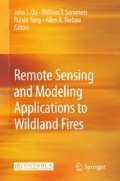Abstract
Grassland fires on level terrain offer a good basic scenario for test wildland fire behavior models, due to the simplicity and homogeneity of the fuels and terrain. Two physics based models, FIRETEC and WFDS, are briefly described, applied fire spread in grassland fuel, followed by a discussion of the results. It is important to note that both models have undergone appreciable development since the writing of this conference paper in 2005.
Access this chapter
Tax calculation will be finalised at checkout
Purchases are for personal use only
Preview
Unable to display preview. Download preview PDF.
References
Albini FA, (1985), Wildland fire spread by radiation—a model including fuel cooling by natural convection. Combust. Sci. Tech. 45: 101–113
Andrews PL, (1986), BEHAVE: Fire behavior prediction and modeling system—BURN subsystem part 1. USDA For. Serv. Gen. Tech. Rep. INT-194. See also http://www.fire.org
Bilger RW, (1970), Turbulent Reacting Flows. Chap. 4 in Turbulent Flows with Nonpremixed Reactants, Springer-Verlag
Cheney NP, Gould JS, Catchpole WR, (1993), The influence of fuel, weather and fire shape variables on fire spread in grasslands. Int. J. Wildland Fire, 3: 31–44
Cheney NP, Gould JS, (1995), Fire growth in grassland fuels. Int J. Wildland Fire, 5: 237–347
Cheney NP, Gould JS, Catchpole WR, (1998), Prediction of fire spread in grasslands. Int. J. Wildland Fire, 8: 1–13
Colman JJ, Linn RR, (2003), Non-local chemistry implementation in HIGRAD/FIRETEC. 2nd Intnl. Wildland Fire Ecology and Fire Manage. Congress and 5th Symp. on Fire on Forest Meteorology, 16–20 November, Orlando, FL, American Meteorological Society
Fons WL, (1946), Analysis of fire spread in light forest fuels. J. Agricultural Res., 72: 93–121
Forney GP, McGrattan KB, (2004), User’s Guide for Smokeview Version 4: A Tool for Visualizing Fire Dynamics Simulation Data. NIST Special Publication 1017, http://fire.nist.gov/bfrlpubs/
Finney MA, (1998), FARSITE: Fire Area Simulator-Model, Development and Evaluation. USDA Forest Service, Rocky Mountain Research Station Paper, RMRS-RP-4
Hirsch KG, (1996), Canadian forest fire behavior prediction (FBP) system: user’s guide. Canadian Forest Service, Special Report 7, Northwest Region, Northern Forestry Centre
Larini M, Giroud F, Porterie B, Loraud J-C, (1998), A multiphase formulation for fire propagation in heterogeneous combustible media. Int. J. Heat Mass Trasfer, 41: 881–897
Linn RR, (1997), A transport model for prediction of wildfire behavior. Ph. D. thesis, New Mexico State University, also published as Los Alamos Report, LA-13334-T
Linn R, Reisner J, Colman JJ, Winterkamp J, (2002), Studying wildfire behavior using. FIRETEC, Int. J. Wildland Fire, 11: 233–246
Linn R, Cunningham P, (2005), Numerical simulations of grass fires using a coupled atmosphere-fire model: Basic fire behavior and dependence on wind speed. J. Geophysical Research, 110
McGrattan KB, (2004), Fire Dynamics Simulator (Version 4), Technical Reference Guide. NISTIR Special Publication 1018, McGrattan K (ed), http://fire.nist.gov/bfrlpubs/
McGrattan KG, Forney G, (2004), Fire Dynamics Simulator (Version 4), Users Guide. NISTIR Special Publication 1019, http://fire.nist.gov/bfrlpubs/
Mell WE, Lawson JR, (2000), A Heat Trasfer Model for Firefighters’ Proctective Clothing. Fire Technology, 36: 39–68
Mell W, Jenkins MA, (2007a), A physics based approach to modeling grassland fires. Int. J. Wildand Fire, 16: 1–22
Mell W, Rehm R, Maranghides A, Manzello S., Forney, G., (2007b), Wildland-Urban Interface and Wildland Fires. http://www2.bfrl.nist.gov/userpages/wmell/public.html
Mell W, Maranghides A, McDermott R, Manzello S, (2007c), Numerical simulation and experiments of burning Douglas fir trees. Submitted to Combustion Theory and Modeling.
Morvan D, Dupuy JL, (2004), Modeling the propagation of a wildfire through a Mediterranean shrub using a multiphase formulation. Comb. Flame, 138: 199–210
Nobel IR, Bary GAV, Gill AM, (1980), McArthur’s fire-danger meters expressed as equations. Aus. J. of Ecol., 5: 210–203
Ozisk MN, (1973), Radiative Heat Transfer and Interactions with Conduction and Convection. John Wiley & Sons, 1st Edition
Pastor E, Zarate L, Planas E, Arnaldos J, (2003), Mathematical models and calculations systems for the study of wildland fire behavior. Prog. Energy. Combust. Sci. 29: 139–153
Rehm RG, Baum, HR, (1978), The Equations of Motion for Thermally Driven, Buoyant Flows. Journal of Research of the NBS, 83: 297–308
Rehm R, Evans D, Mell W, Hostikka S, McGrattan K, Forney G, Bouldin C, Baker E, (2003), Neighborhood-Scale Fire Spread. 5th Symposium on Fire and Forest Meteorology, November 16–20, American Meteorological Society, J6.7
Raithby GD, Chui EH, (1990), A Finite-Volume Method for Predicting Radiant Heat Transfer in Enclosures with Participating Media. J. Heat Transfer, 112: 415–423
Reisner J, Wynne S, Margolin L, Linn R, (2000), Coupled Atmosphere-Fire Modeling Employing the Method of Averages. Monthly Weather Review 128: 3683–3691
Rothermel RC, (1972), A mathematical model for predicting fire spread in wildland fuels. Research Paper INT-115, Intermountain Forest and Range Experiment Station, Odgen, Utah, USA
Smagorinksy J, (1963), General Circulation Experiments with the Primitive Equations I. The Basic Experiment. Monthy Weather Reivew 91: 99–164
Stephens GL, (1984), The parameterization of radiation for numerical weather prediction and climate models. Monthly Weather Review 112: 826–867
Author information
Authors and Affiliations
Editor information
Editors and Affiliations
Rights and permissions
Copyright information
© 2013 Tsinghua University Press, Beijing and Springer-Verlag Berlin Heidelberg
About this chapter
Cite this chapter
Mell, W., Charney, J., Jenkins, M.A., Cheney, P., Gould, J. (2013). Numerical Simulations of Grassland Fire Behavior from the LANL-FIRETEC and NIST-WFDS Models. In: Qu, J.J., Sommers, W.T., Yang, R., Riebau, A.R. (eds) Remote Sensing and Modeling Applications to Wildland Fires. Springer, Berlin, Heidelberg. https://doi.org/10.1007/978-3-642-32530-4_15
Download citation
DOI: https://doi.org/10.1007/978-3-642-32530-4_15
Publisher Name: Springer, Berlin, Heidelberg
Print ISBN: 978-3-642-32529-8
Online ISBN: 978-3-642-32530-4
eBook Packages: Earth and Environmental ScienceEarth and Environmental Science (R0)

